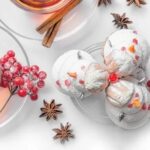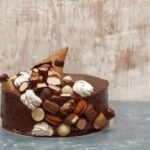When it comes to cake decoration, one key element that can take your creations to the next level is fon. But what is fon in cake decoration exactly? Fon refers to various types of edible materials used to decorate cakes, such as royal icing, fondant, gum paste, and modeling chocolate. These versatile mediums allow decorators to create intricate designs, from delicate flowers to elaborate figurines, elevating the aesthetic appeal of their baked goods.
The history of fon in cake decoration dates back centuries, with its cultural significance evident in various traditions and celebrations around the world. Over time, fon has evolved to become a staple in the industry, offering decorators a wide range of options to bring their creative visions to life. Whether it’s a classic wedding cake or a whimsical birthday treat, fon plays a crucial role in transforming simple desserts into works of art.
In this comprehensive guide, we will explore the different types of fon used in cake decoration and delve into the techniques for working with them. From coloring and shaping fondant to molding intricate details with modeling chocolate, we will provide step-by-step instructions and essential tips for beginners and experienced decorators alike. So grab your tools and get ready to unleash your creativity with fon.
History of Fon
Fondant, commonly referred to as fon in the world of cake decoration, has a rich history that dates back centuries. It originated in Europe, where it was used as a luxurious icing for special occasion cakes among the elite. Over time, fondant has evolved and become more accessible to home bakers and professional cake decorators alike, transforming into an essential element in creating intricate and elaborate designs on cakes.
Types of Fondant
When it comes to fon in cake decoration, there are several types to choose from, each with its own unique characteristics and uses. Some of the most popular types of fondant include:
- Royal Icing: A smooth and shiny icing made from confectioner’s sugar and egg whites, perfect for intricate piping work.
- Fondant: A pliable icing made from sugar, water, gelatin, and glycerin that can be rolled out to cover cakes or molded into various shapes.
- Gum Paste: A firmer type of fon made from powdered sugar, gelatin, corn syrup, and shortening that dries quickly and is ideal for making lifelike flowers and decorations.
- Modeling Chocolate: Made from chocolate mixed with corn syrup or glucose syrup, modeling chocolate is versatile for sculpting detailed figures and designs on cakes.
Tools Needed for Working With Fon
In order to effectively work with fon in cake decoration, it is important to have the right tools at hand. Some essential tools needed include:
- Rolling Pin: Used to roll out fondant into thin sheets for covering cakes or cutting out shapes.
- Cutters: Various shaped cutters are essential for cutting out fondant pieces for decorations like flowers or leaves.
- Molds: Silicone molds come in handy for creating intricate details or textures on fondant decorations.
- Piping Bags: Used for piping royal icing or buttercream frosting onto cakes for additional decorative elements.
By understanding the history of fon in cake decoration and familiarizing oneself with the different types and tools available, aspiring decorators can elevate their skills in creating visually appealing desserts that are sure to impress any audience.
Types of Fon
Royal Icing
Royal icing is a versatile and classic type of fon used in cake decoration. Made primarily from powdered sugar, egg whites, and flavoring, royal icing has a smooth texture that hardens when dried, making it ideal for intricate designs like lacework, flowers, and lettering. This type of fon is often used for creating details on cookies, gingerbread houses, and wedding cakes due to its delicate appearance and ability to hold its shape well.
Fondant
Fondant is another popular choice for cake decorators looking to achieve a smooth and seamless finish on their creations. This pliable type of fon is made from sugar, water, gelatin or glucose syrup, giving it a dough-like consistency that can be rolled out and draped over cakes to create a flawless outer layer.
Fondant comes in various colors and can be flavored with extracts or oils for added taste. It is perfect for covering larger cakes or sculpting 3D figures due to its malleable nature.
Gum Paste
Gum paste is a firmer type of fon that dries quickly and maintains its shape well, making it ideal for creating intricate embellishments like flowers, leaves, bows, and figurines. Made from powdered sugar, gum tragacanth or tylose powder, water, and shortening, gum paste needs to be kneaded thoroughly before use to activate the gum’s elasticity.
This fon dries hard but remains edible, making it an excellent choice for decorative elements that need to stand upright on cakes without sagging or losing their form.
Techniques for Using Fon
Coloring Fon
When it comes to coloring fon for cake decoration, there are several options available. One popular choice is using gel food coloring, as it provides vibrant and concentrated colors without altering the consistency of the fon. To add color to fondant, start by kneading a small amount of gel food coloring into the fon until it is evenly distributed. Add more color as needed to achieve the desired shade, keeping in mind that fon tends to darken as it sits.
Shaping and Molding Fon
To shape and mold fon into various designs for cake decoration, make sure to work with a clean surface and lightly dust it with cornstarch or powdered sugar to prevent sticking. Use a rolling pin to roll out the fondant evenly to your desired thickness, then gently lift it and place it over the cake.
Smooth out any wrinkles or bubbles with a fondant smoother or your hands, starting from the center and working towards the edges. For intricate shapes and designs, use fondant cutters or molds to create detailed decorations.
Tips for Working With Fondant
Working with fon in cake decoration requires patience and practice to master different techniques. When shaping fon into 3D figures or objects, ensure that you allow each piece to dry slightly before assembling them together. This will help maintain their shape and prevent them from collapsing.
Additionally, if you find that the fon is becoming too dry or sticky while working with it, try adding a small amount of vegetable shortening or corn syrup to restore its texture. Remember that experimentation is key in mastering fon decoration, so don’t be afraid to get creative and try new techniques.
Tools Needed for Fon
When it comes to cake decoration, having the right tools and equipment is essential for working with fondant (fon) effectively. The tools needed for fon work play a crucial role in shaping, molding, and decorating cakes with intricate designs. One of the most basic tools required for fon decoration is a rolling pin. A good quality rolling pin helps in evenly rolling out the fondant to the desired thickness without causing any cracks or tears in the material.
Another essential tool for working with fon is various types of cutters. Cutters come in different shapes and sizes, allowing decorators to create unique fon designs for cakes. Whether you are looking to make flowers, leaves, or geometric patterns on your cake, having a set of cutters is indispensable in achieving clean and precise cuts with fondant.
Molds are also important tools when it comes to fon decoration. Molds come in handy when creating intricate details like lace patterns, borders, or three-dimensional figurines on cakes. Using molds can help decorators replicate complex designs with ease and precision on fondant-covered cakes. Additionally, piping bags are essential tools for working with royal icing or buttercream along with fon decorations, adding details like piped borders or delicate lettering to cakes.
| Tools | Importance |
|---|---|
| Rolling Pin | Helps in evenly rolling out fondant |
| Cutters | Allow decorators to create unique designs |
| Molds | Aid in creating intricate details on cakes |
| Piping Bags | Used for adding fine details like borders and lettering |
Common Mistakes to Avoid
When working with fon in cake decoration, there are common mistakes that beginners and even experienced bakers can make. One of the most frequent errors is not properly kneading fondant before using it. Kneading fondant helps to soften it, making it easier to work with and preventing cracks or tears when covering a cake. To avoid this mistake, it is important to knead fondant until smooth and pliable before rolling it out.
Another mistake to watch out for is overusing powdered sugar or cornstarch when rolling out fondant. While these are commonly used to prevent sticking, using too much can dry out the fondant and cause it to crack. Instead, use a light dusting of powdered sugar or cornstarch and consider using shortening on your work surface for a smoother finish.
Additionally, not allowing enough time for decorations to dry properly is another common mistake in cake decorating with fon. Whether you are creating flowers, figures, or other intricate designs, proper drying time is essential to ensure they hold their shape and do not collapse when placed on the cake. To prevent this mistake, allow decorations to dry completely before placing them on the cake.
| Mistake | Solution |
|---|---|
| Not kneading fondant properly | Knead fondant until smooth and pliable before use |
| Overusing powdered sugar or cornstarch | Use minimal amounts for dusting and consider shortening on work surface |
| Not allowing enough drying time for decorations | Ensure decorations dry completely before placing them on the cake |
Inspirational Fon Designs
Fondant, commonly known as fon in the world of cake decoration, is a versatile and popular medium used to create intricate designs on cakes, cupcakes, and cookies. Fondant is a pliable sugar paste that can be rolled out and molded into various shapes and figures, making it a favorite among bakers and pastry chefs for its artistic possibilities.
Whether you are looking to add a touch of elegance to a wedding cake or create whimsical decorations for a birthday celebration, fondant offers endless creative opportunities.
To truly grasp the artistry of fondant in cake decoration, one must explore the incredible designs that can be achieved with this edible medium. From delicate flowers to intricate lace patterns, fondant allows for precise detailing and customization that can elevate any dessert to a work of art. By showcasing stunning examples of fon decorations on cakes, cupcakes, and cookies, readers can draw inspiration from these masterpieces and learn how to incorporate similar techniques into their own creations.
Examples of Inspirational Fon Designs
- A wedding cake adorned with cascading sugar flowers and intricate lace patterns
- Cupcakes topped with miniature fondant bows and edible gold leaf accents
- Cookies decorated with colorful fondant cutouts in fun shapes like animals or stars
These examples serve as a testament to the endless possibilities that fon offers in cake decoration. By experimenting with different colors, textures, and shapes, bakers can unleash their creativity and design show-stopping desserts that are sure to impress any audience. Additionally, by honing their skills in working with fon through practice and experimentation, aspiring decorators can develop their own unique style and bring their imaginative visions to life on edible canvases.
Conclusion
In conclusion, the concept of fon in cake decoration is a vital element that plays a significant role in creating visually stunning and intricate designs. From its historical roots to the wide array of types available, fon has become an essential tool for bakers and decorators looking to elevate the aesthetic appeal of their creations. The versatility of fon, whether it be royal icing, fondant, gum paste, or modeling chocolate, allows for endless possibilities in design and creativity.
Utilizing fon in cake decoration requires not only the right tools but also knowledge of techniques such as coloring, shaping, and molding. By following step-by-step instructions and avoiding common mistakes, decorators can achieve flawless results that truly showcase their skills and artistry. With the right tools like rolling pins, cutters, molds, and piping bags at hand, working with fon becomes a seamless process that opens up a world of creative opportunities.
As seen in the inspirational fon designs showcased throughout this blog post, incorporating fon into cake decorating can truly transform ordinary desserts into works of art. Whether it’s elaborate fondant sculptures or delicate royal icing piping details, fon allows decorators to push boundaries and create show-stopping confections.
In essence, understanding what fon is in cake decoration not only enhances the visual appeal of cakes and desserts but also adds a layer of craftsmanship that sets them apart from the rest.
Frequently Asked Questions
What Is Fondant Made Out Of?
Fondant is made out of sugar, water, and corn syrup. It is heated to a precise temperature and then kneaded into a pliable mass used for covering cakes or making decorations.
Is Fondant Meant to Be Eaten?
Fondant is technically meant to be eaten, but many people find it too sweet or dislike its texture. Some prefer to peel it off before consuming the cake underneath.
What Is the Meaning of Fondant on a Cake?
Fondant on a cake serves both aesthetic and practical purposes. It provides a smooth surface for decorating, allowing for intricate designs that are difficult to achieve with buttercream. Additionally, fondant helps seal in moisture, keeping the cake fresh for longer periods of time.

Welcome to my blog about home and family. This blog is a place where I will share my thoughts, ideas, and experiences related to these important topics. I am a stay-at-home mom with two young children. I hope you enjoy reading it! and may find some helpful tips and ideas that will make your home and family life even better!





